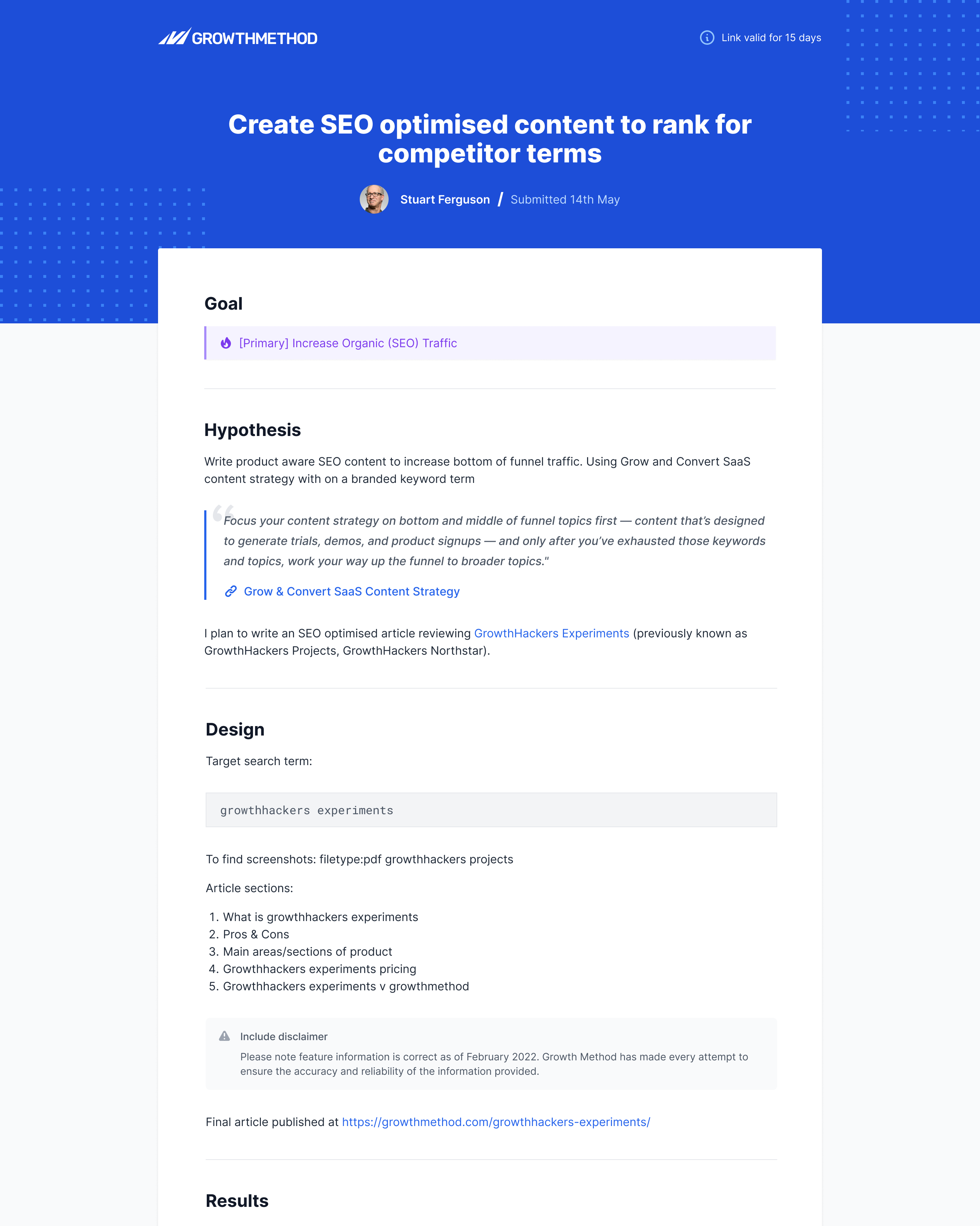Reforge Growth Series: Acquisition
Article originally published in April 2024 by Stuart Brameld. Most recent update in April 2024.
Request a demo
Project management for growth and agile marketing professionals. Map your acquisition funnel, integrate analytics and run agile experiments.
Experiment results
Recent experiments results include competitor SEO, AI-driven content, exit-intent modals and AB testing homepage headlines.
Case study
"We are on-track to deliver a 43% increase in inbound leads this year. There is no doubt the adoption of Growth Method is the primary driver behind these results."
![]()
Certified
We are vetted mentors with Growth Mentor and a partner with the Agile Marketing Alliance.
The article provides our notes from the excellent Growth Series Course on Reforge.
The game has changed – need a growth engine that is Sustainable, Repeatable and Systematic.
Systems Not Silos
Guiding principles for acquisition channels:
- Channel Dynamics
- Product Channel Fit
- Channel Model Fit
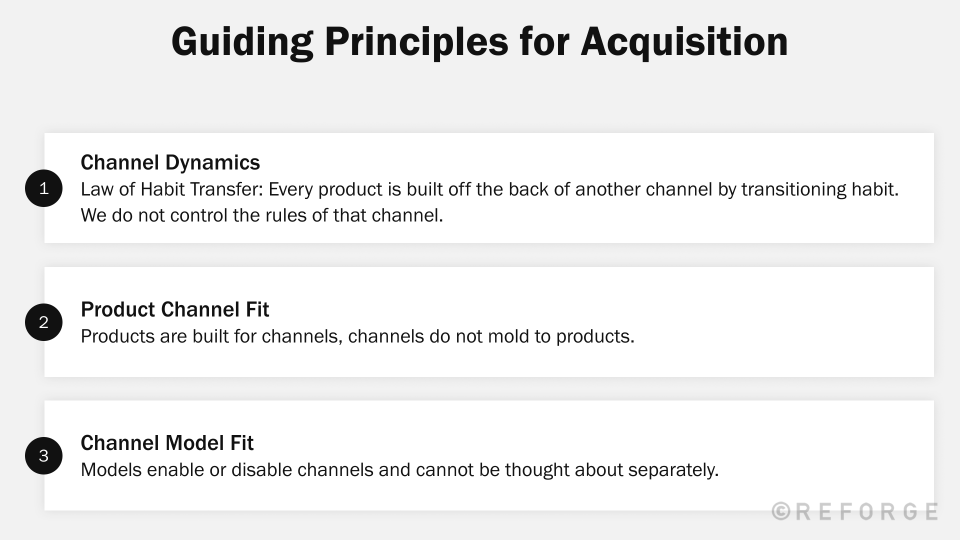
Channel Dynamics
Existing Habtis / The law of habit transfer – our target audience has habits with other products, devices, and places.
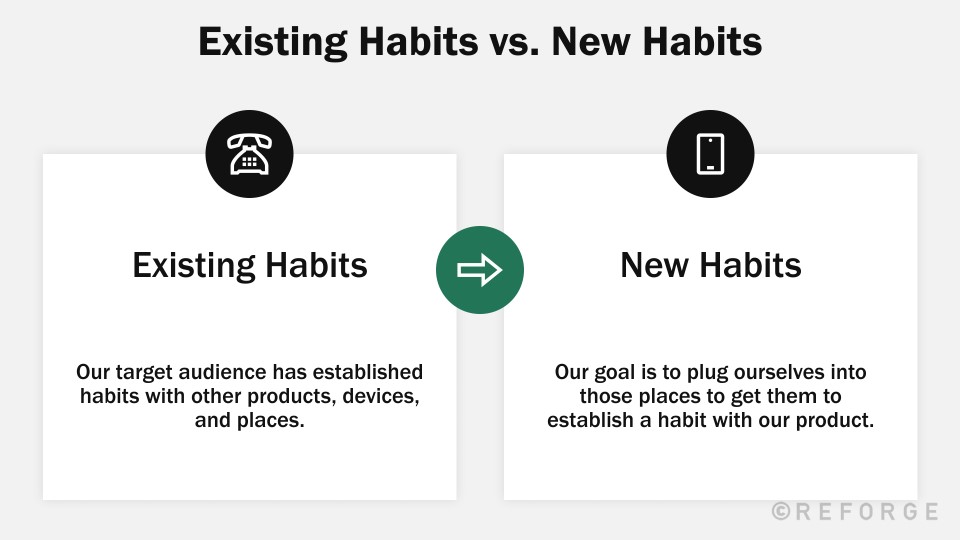
Every channel, every company, is built off the back of anothre channel. We do not control the rules of the channel or the channel dynamics so have to consider how can we mould to them.
Additional channels are changing faster than ever.
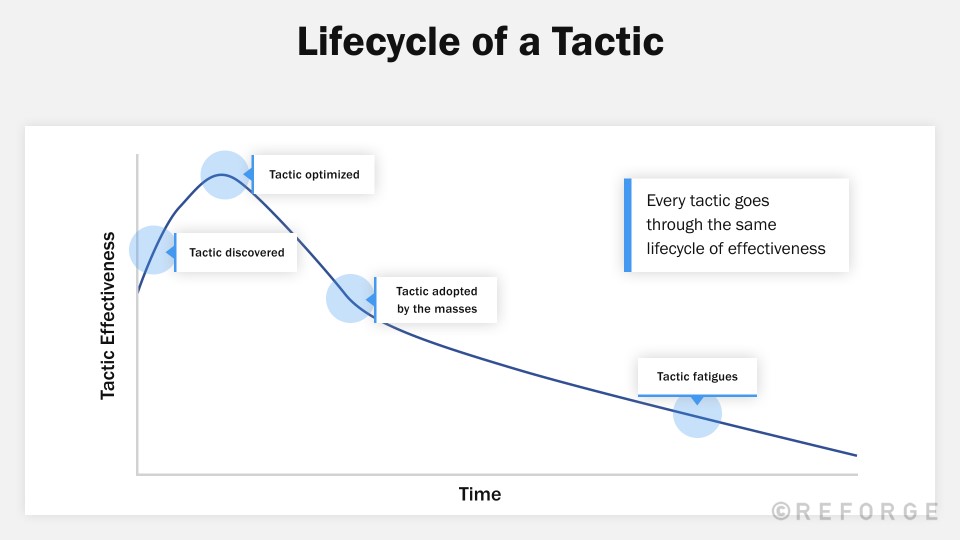
Product Channel Fit
Cannot treat your product and acquisition in complete sios to one another. Products are made to fit channels, channels do not mould to products because we do not control the channel dynamics and every company is built off of the back of another larger channel.
Need to think about product and acquisition channel together, not as silos.
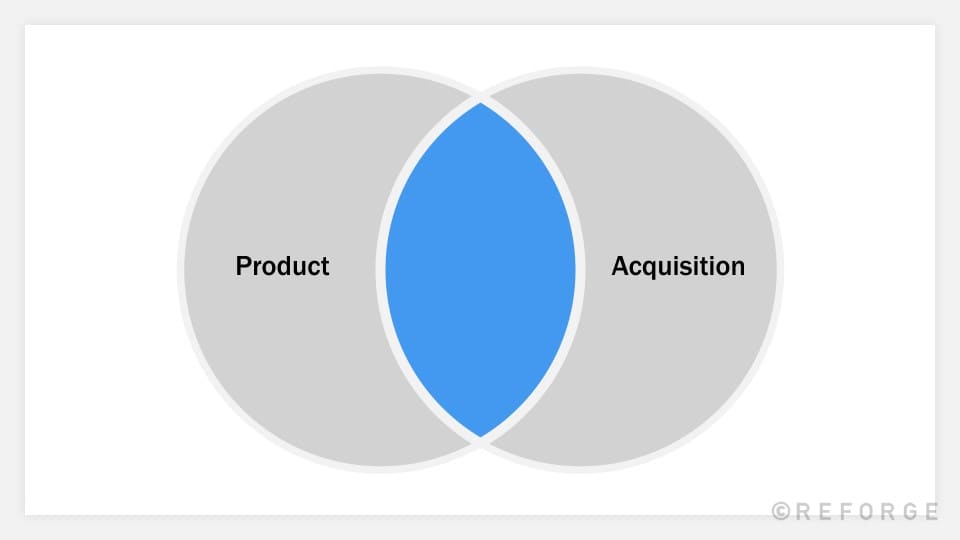
Channel Model Fit
Have to align yourself on the ARPU/CAC spectrum e.g. low ARPU CAC on low cost channels (e.g. Facebook), and high ARPU CAC and higher CAC channels (e.g Enterprise sales).
This is channel model fit – monetisation models enable or disable certain channels. As go up marketing, low friction channels won’t have the necessary influence.
Loops not funnels
So how do we look at Product, Acquisition Channel and Monetisation Model together? The answer is Loops, not funnels. This is the guiding principle.
Acquisition Loops
Most people tend to think about acquisition as funnels – the AARRR funnel. But there are 3 problems with this funnel framework.
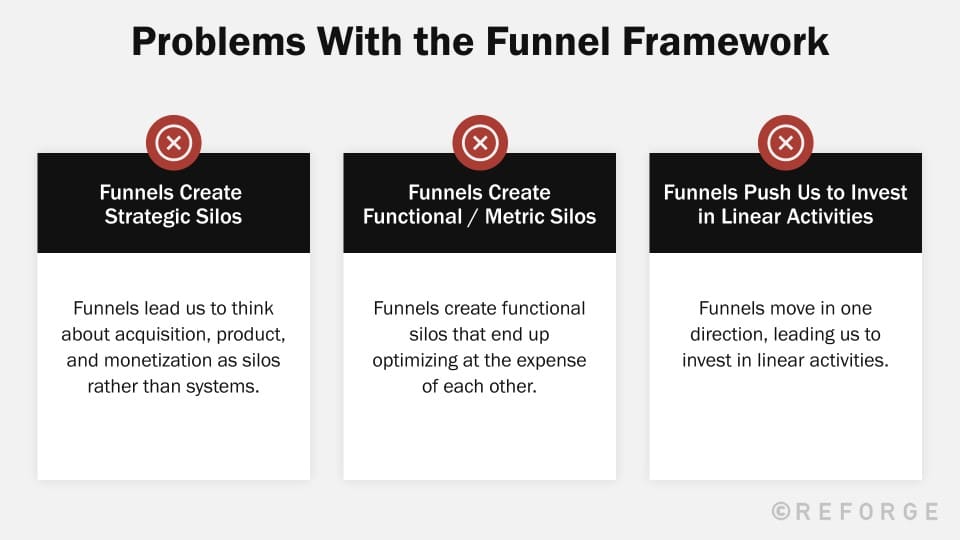
- Funnels create strategic silos – can’t think about acquisition strategic siloe’d from product and monetisation model
- Funnels create metric silos – creates functional and metric silos as orgs organise team by funnel stage e.g. marketing owns acquisition, product owns activation, sales owns revenue
- Funnels push towards liner activities – funnels move in one direction, lead to an assumption of needing more in the top (more tactics, channels, money etc) but this is unsustainble
Instead of funnels, the best companies are built on systems of compounding loops. How does one cohort of users lead to another cohort of users?
The acquisition loop acts like compound interest over time.
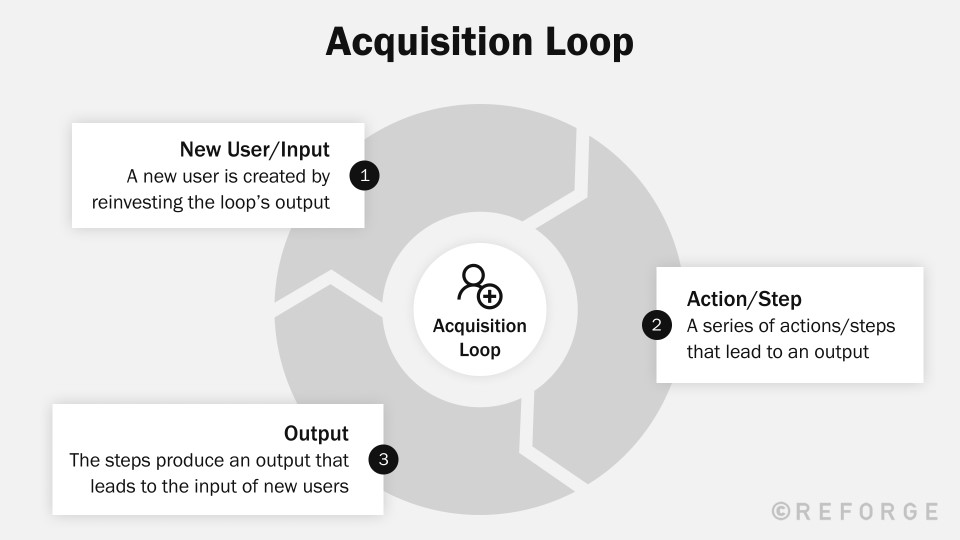
Why loops are so important:
- If you aren’t compounding, you are dying.
- Loops are more defensible
- Loops create a more efficient cost of distribution over time.
Four categories of acquisition loops
A loops answers the question – how does one cohort of users lead to another cohort of users? Making acquisition act like compound interest.
- Viral Loops – someone signs-up, a % invite friends, a % click and create new users e.g. Slack and Drift
- Content Loops – a % create content, % of content is indexed or found and % find it and leads to more users
- Paid Loops – % revenue is reinvested into buying more ads for each new user/cohort
- Sales Loops – as new users are onboarding, revenue is used to add more sales reps
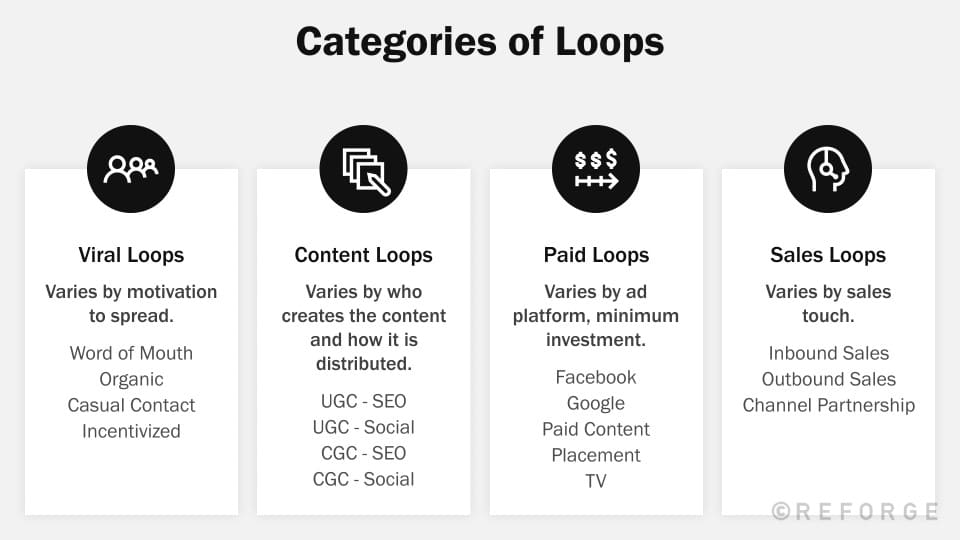
Many of the fastest growing companies layer different types of loops over time.
Measuring Your Loops
Every loop as costs (people, time and money) and returns (number of new users generated). The growth multiplier is how we measure and compare loops.
If we put one user into the loop, how many more users are product over time?
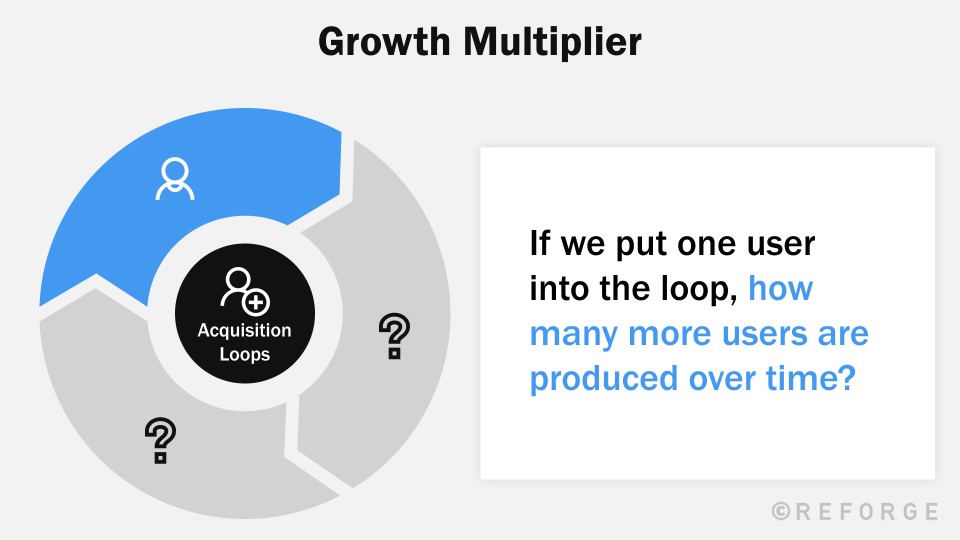
The Growth Multiplier shows how small improvements in loops can lead to big results over time (you can think of this like a conversion rate improvement).
Loops Vs Linear
How do you determine – when is something a loop, and when is it linear?
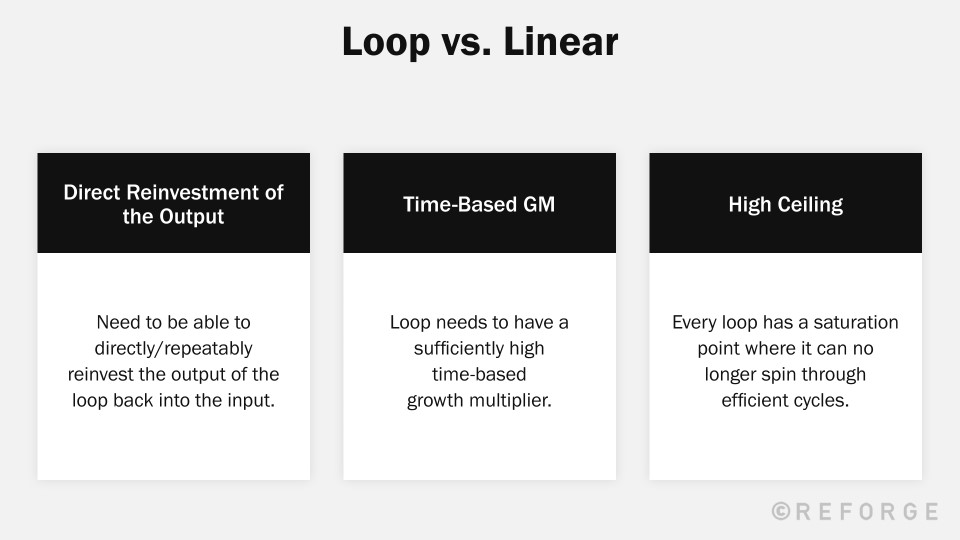
Despite loops, linear channels are not completely useless as:
- They can be used to help continually feed loops
- They can be used to build loop activation energy
Viral Loops
Viral loops are not new. In 1935 the first money chain letter appeared. it was called the Infamous Send a Dime. It ended up flooding the world within a few months.
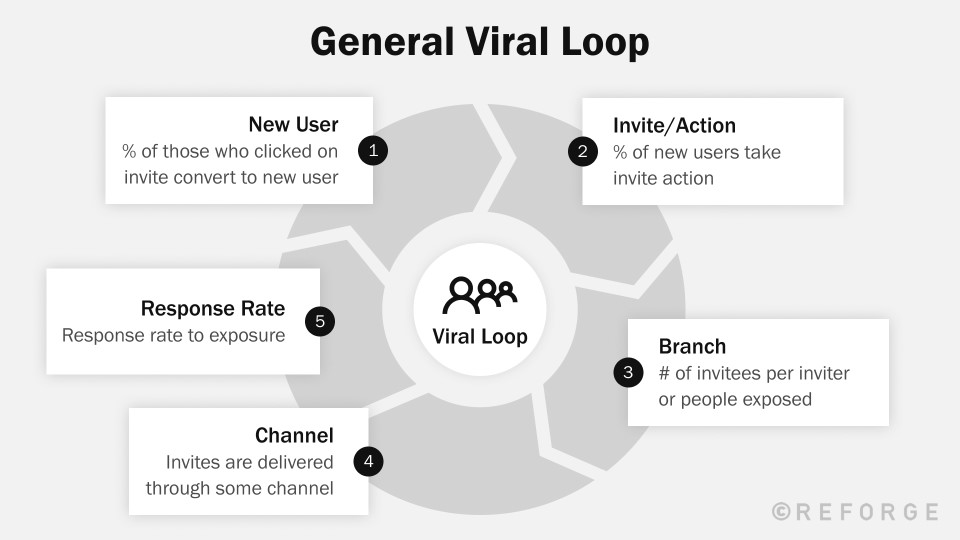
There are 4 types of viral loop
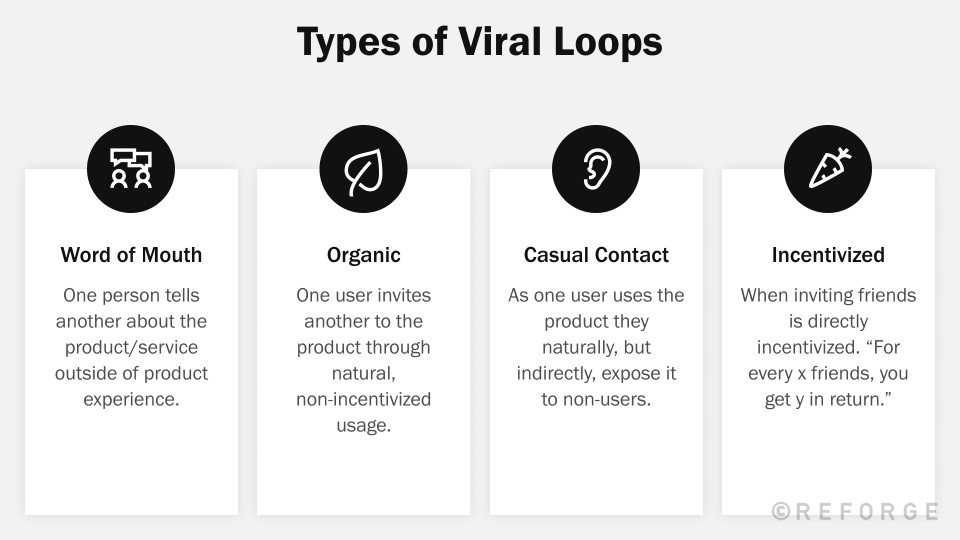
The viral coefficient is known as the K-factor. Every viral signup creates K new users. This eventually flattens as it hits the saturation point of a users network. The K factor will likely also change over time e.g with dropbox, when a user hits a storage limit, have a high incentive to invite more people to increase their limit.
Organic viral loops – triggered through natural, non-incentivised usage e.g LinkedIn, Airtable, Slack etc. Often through natural collaboration or communication. Can also be when inviting team after initial signup, though this would only happen once. Ideally want high frequency and response rates to your organic viral loop.
Casual contact viral loops – a user indirectly attract other users through natural usage e.g. Mailchimp, Drift, Wista etc. Often has low response rate, hence need extremely high exposure and multiple exposures of a long period of time. Effects of casual contact loops can show-up in other channels.
Incentivised viral loops – use of some manufactured incentive e.g. Uber, airbnb, Wealthfront etc. Can incentivise by giving users money, content or product features. Have to consider how meaningful the incentives and how well aligned they are to both the giver and receiver.
Content loops
Content loops are where we create and distribute content in a way that attracts more users. There are 4 types of content loops based on who is generating the content, who is distributing the content, and where the amplification happens.
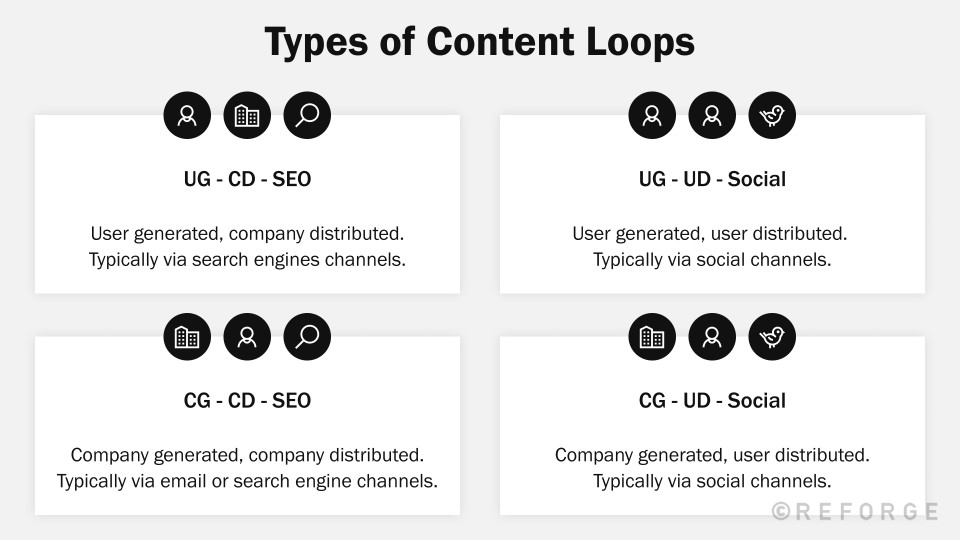
The primary constraints of content loops are the cost/volume of content being generated and the return per piece of content.
- User generated content loops – users create content through product usage that attracts more users e.g. Medium (via SEO), gofundme (via press), LinkedIn (via SEO) etc. Considerations with this UGC loops include the core motivation for the user to generate the content, the volume created and the return over time.
- Company generated content loops – e.g. HubSpot, Gainsight etc. Main constraint is return due to the cost of the company creating the content. Can company generated by paired with user distributed in order to maximise the return?
Paid Loops
A paid loop occurs when a company distributes a paid ad that attracts more users and customers and that money can then be reinvested in more ads. Used by companies like HeadSpace, Casper, Postmates and many more.
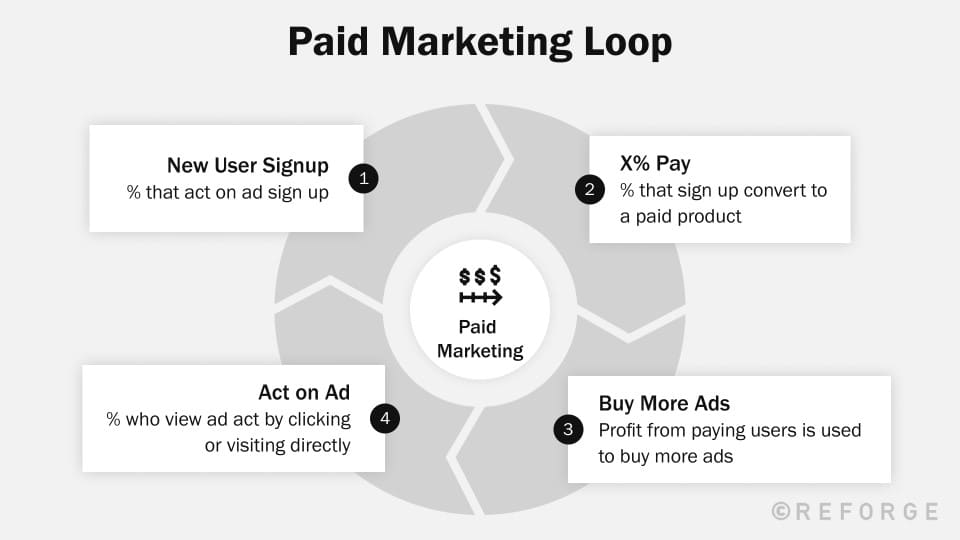
The differences in how paid channels vary will influence your paid loop.

When looking at paid marketing loops and thinking about the primary constraint on performance, it’s always going to be how much capital we have to reinvest in the loop.
How to measure paid loops? Many companies use LTV : CAC but this has no concept of velocity. It is better to use ROAS for paid viral loops as it consider how fast you earn your money back. ROAS shows the shape and speed of returned capital that can be reinvested.
Using paid loops
There are 3 main advantages to using paid loops
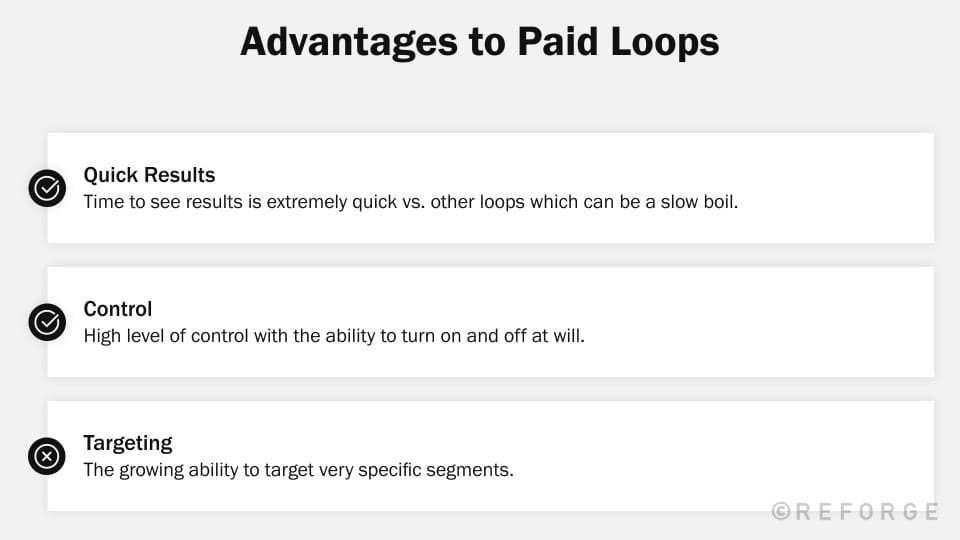
Note: paid loops are one of the least sustainable loops over time as ads are scaled you end up reaching out to less and less qualified people (leading to increasing CAC, decreasing LTV and significantly increased payback period). To counter this, companies should use paid loops to drive another type of viral loop (consider paid loops as a fuel or accelerant for other loops, not a loop of their own).
Sales Loops
Use a sales force to attract more customers, and reinvest the capital to buy adding more sales people. Sales loops are always paired with another kind of loop to generate leads (similar to paid loops). Sales loops are not mutually exclusive.
There are 4 kinds of sales loops – Outbound, VAR, Inbound and Product – and these can be thought of as ranging from in terms of efficiency (low to high) and number of touches (human to product).
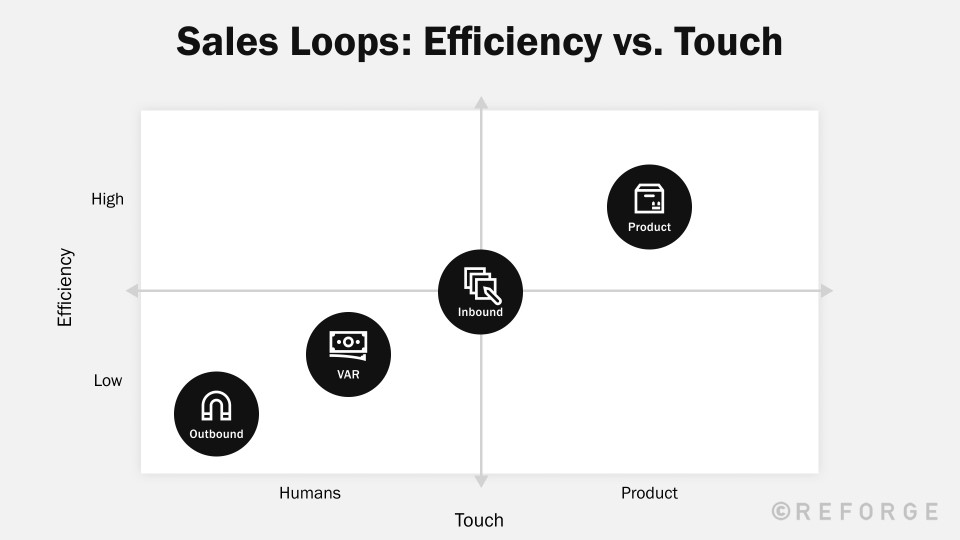
There are 3 primary constraints on any kind of sales loop – we want to align metrics to these constraints to monitor effectiveness.
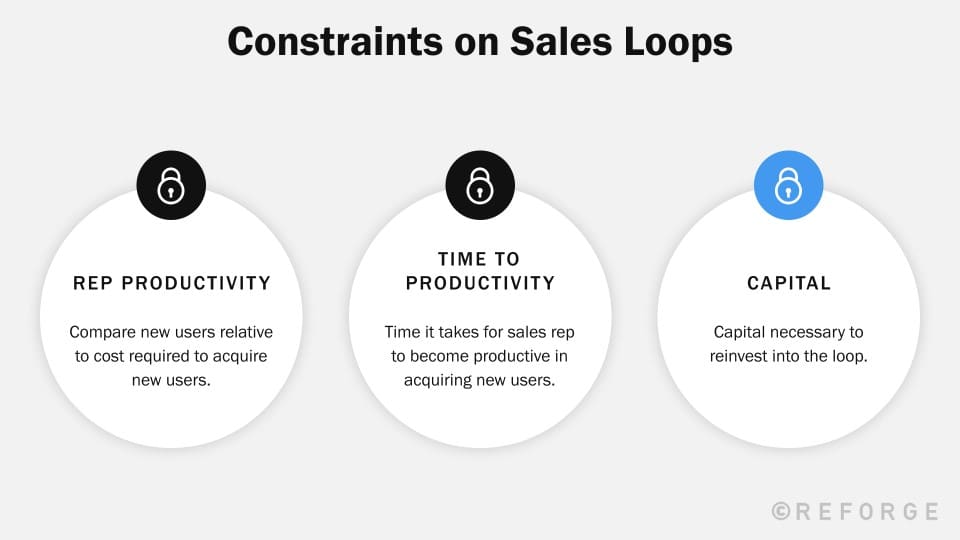
1 Outbound sales loops
SDRs used to generate leads, used by a lot of enterprise companies. Can take a long time to get a sales person productive. Good when targeting high touch high friction enterprise companies.
2 Value added reseller (VAR) sales loops
Where someone else is doing the selling to the end customer – the VAR are operating their own sales loop, typically incentivised by the software they sell. More efficient as shifting some of the cost of selling to other companies. Every VAR helps to attract multiple customers hence can be more efficient than the outbound loop.

We need to understand their motivation.
- Why would they actually sell for us?
- What is the constraint around that motivation?
- What is a 10x better alternative that we can provide to them?
3 Inbound sales loops
Using a company generated content loop to generate more leads. Typically combined with some kind of content lead loop as want to pair infrequent buying cycle with a more naturally frequent content cycle. Typically used by companies targeting mid-market companies.
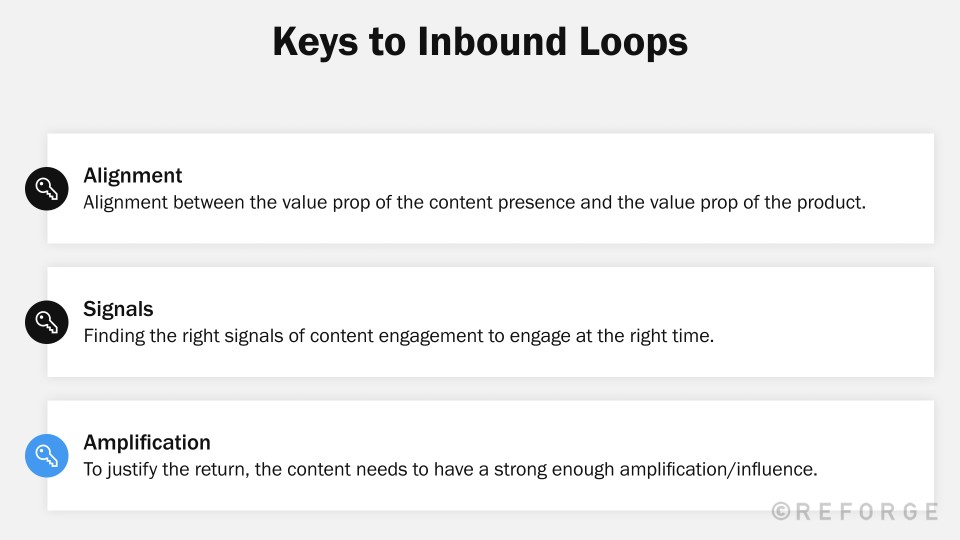
4 Product sales loops
E.g. Slack has a viral loop generating more users and leads.
Different kinds of product signals can be used to qualified PQLs (Product Qualified Leads) signalling different levels of intent. Start with low volume high converting signals, and then try to increase the volume of those signals.
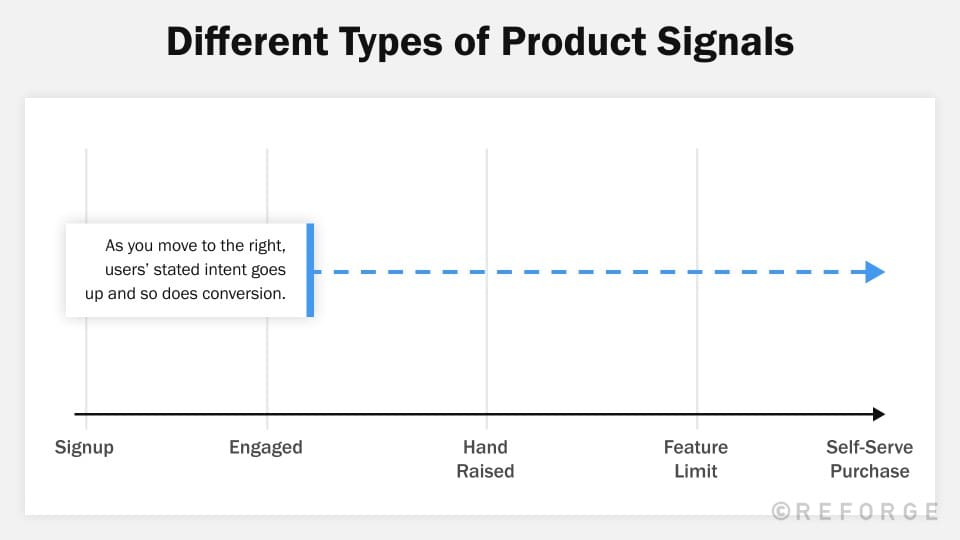
Acquisition Strategy
Every meaningful companies grows based on a system of compounding loops (not funnels). A sustainable, efficiency, compounding growth machine.
A team has the following strategic levers available in terms of improving acquisition strategy to continue growing over time
- Optimise existing loops
- Add new loops
- Increase linear channels to continue feedback loops
1 Optimising existing loops
Optimising existing loops typically either delivers more output per cycle (small changes in loops can lead to big results, hence worth starting here) or more cycles within the same time period (the faster a loop spins, the more it delivers in a given period of time).
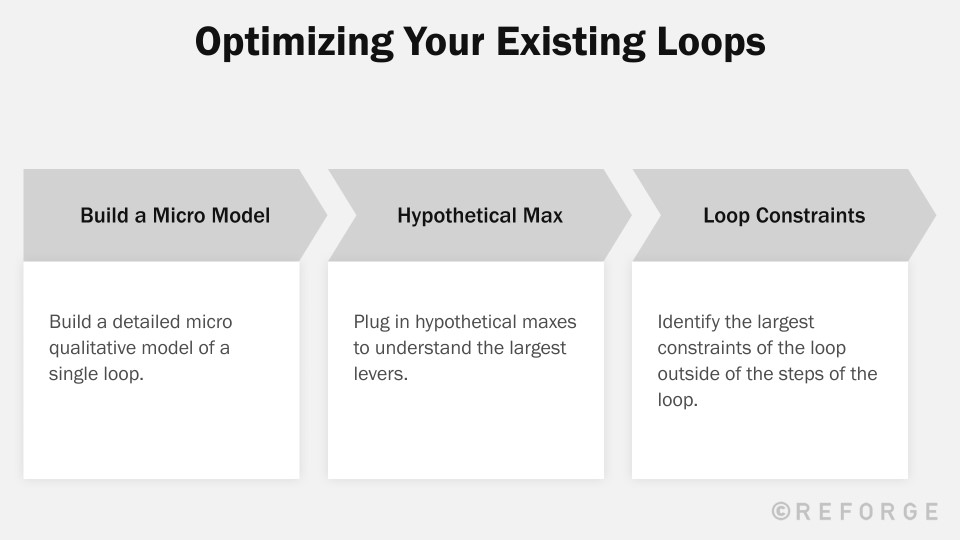
2 Adding new loops
Every loop has a constraint – a saturation point, hence a some point will likely want to consider adding a new loop.
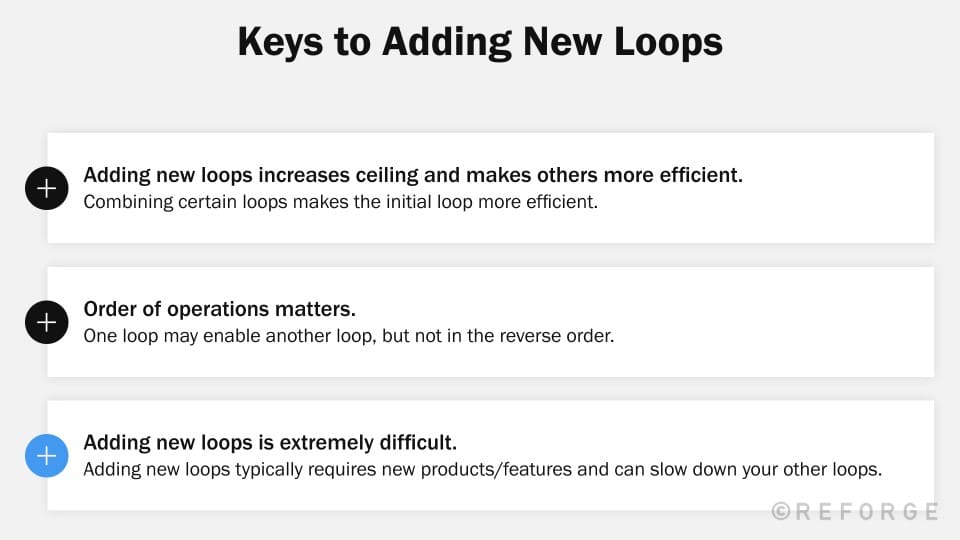
3 Increasing linear channels
Linear activities are typically the lowest-leverage investment of the 3 strategic levers to improve growth as there is no compounding in linear activities, hence we want to use them wisely.

Managing bets over time
It’s important to balance your acquisition investments as we are always fighting a number of forces in different acquisition activities:
- Ceiling & saturation – every loop has a ceiling, every channel has a saturation point
- Audience shift – over time our target audience is likely to shift from one channel to another
- Product channel fit breaking – we do control the rules of the channel, if the channel changes the rules enough this may happen (e.g. Google changing SEO rules)
Balancing investments requires understanding where current loops are in their lifecycle
- Traction – High ROI (as low competition) but also low ceiling. lower risk but lower ceiling, taking a bet that they will increase over time
- Golden Age – high ROI, ceiling goes from low to high, but risk is also high as have to move incredibly fast and move with the channel. high risk but also very high reward.
- Saturation – returns start to flatten off, ROI decreases to medium level, still high ceiling and low risk, but more and more competition. lower risk but ceiling is pretty high.
- Decline – ROI starts to decline as so much competition, ceiling is still high but declining. If channel is declining we will decline with it
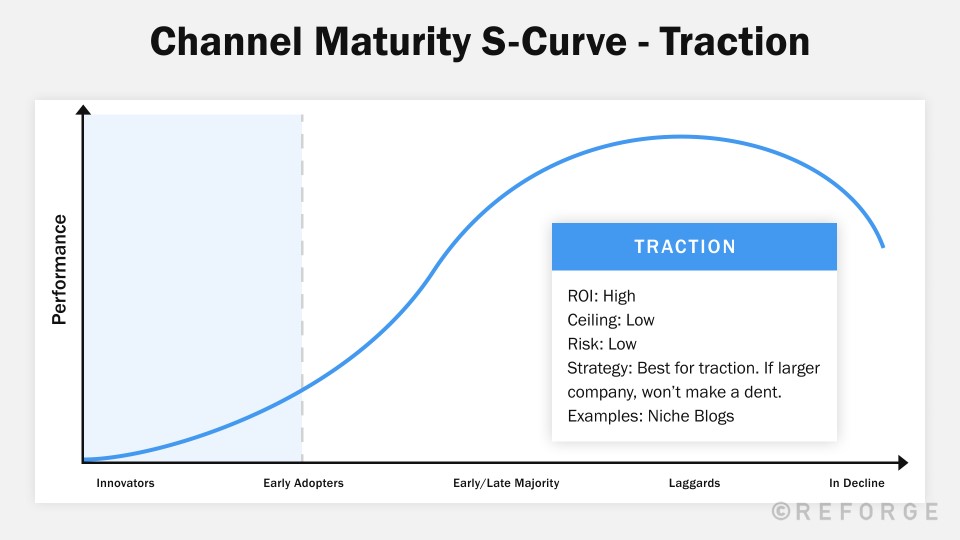
Typically want to use many small linear channels at the start (low risk, but also low upside) to get some initial growth and kick-start one to 2 big loops. The trick is to not pile on more and more small linear channels.
In the traction phase of the company, want to spread bets evenly – want to try to find the golden age channels but sustain growth with traction or saturation channels in the meantime. If find something that works in the golden age channels, we want to shift all our bets here. If channel starts to get saturated or reaching the end o the golden age, want to shift our bets somewhere else.
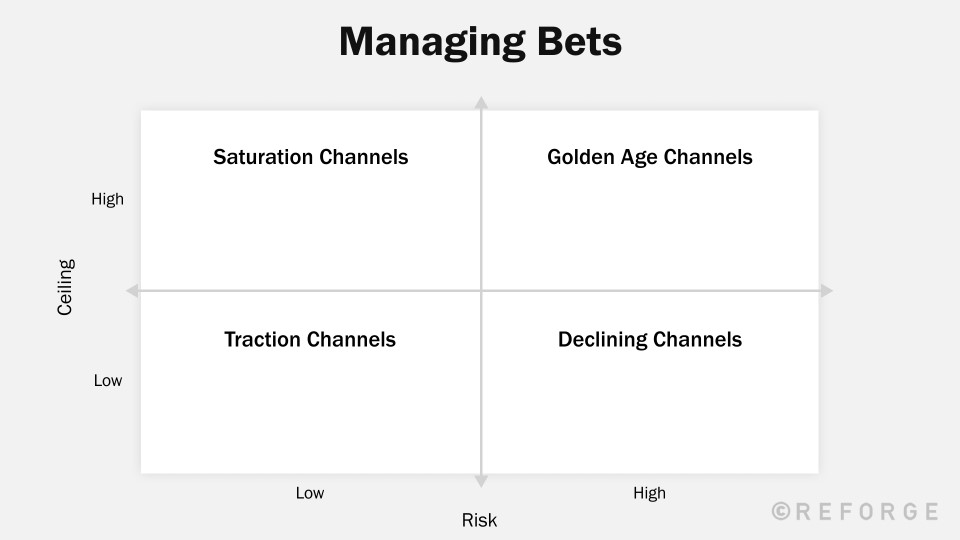
Additional acquisition details
Major levels
There are only a few major levers for product-driven growth:
- Search/SEO – are people searching for what I do already? Is it competitive or not? Is it a new thing / new technology where people haven’t been optimising for search for a long period of time e.g. VR
- Virality – does the product get better for a user if they bring on a friend? can people get a benefit for a referral?
- Conversion – is something preventing people getting to the value and can we reduce friction here?
Building your first 100 day plan
As a growth manager typically have to create or build something to generate results – you want to have a clear win within the first 100 days, in order to get the freedom necessary to not just replicate what others are doing. You may need to hide experiments from your management team.
Viral loops
The core question is – why would someone want to invite their friends, share the content, contribute to the loop? Why is it in the users interest? “Bring your friends and they’ll bring theirs. Get better chats, click here”. Focus on the benefit to the user. (Nick Soman, Founder/CEO @ Decent, previously Reveal Chat).


